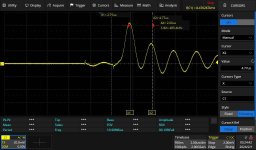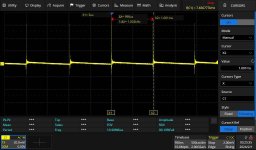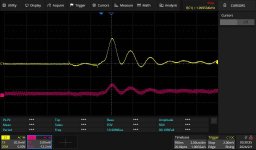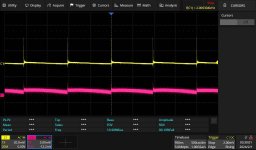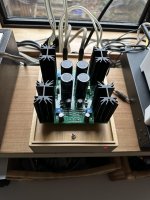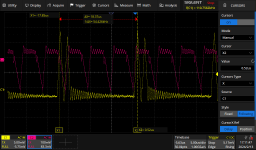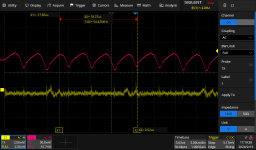Im thinking it works, for me in my setup, because the safety ground, aka analog ground is floating to my DAC, balanced.
And an two way active where I have an MA12070 at HF which dont't like long speaker cables and I have 5 meter coax to my to DAC:s...
That 5V power that is bad and an amp that have an SMPS without any ground give ****.
And then this clean up amazingly!
It sounds stupid I know.
But never had so good HF!
It just cleaned up the sound.
And an two way active where I have an MA12070 at HF which dont't like long speaker cables and I have 5 meter coax to my to DAC:s...
That 5V power that is bad and an amp that have an SMPS without any ground give ****.
And then this clean up amazingly!
It sounds stupid I know.
But never had so good HF!
It just cleaned up the sound.
Last edited:
To address whatever is left, I'd recommend checking out @Mark Johnson 's post earlier in the thread about how to test the output to see where the switcher's noise is centered around and how to measure if the filter is squashing it or not.I built some of these for some years agoe and tried them around but never heard any difference but today I tried one
beacause I had some whining sound from my new DAC and it lowered it remarkabel!
I don't say it all disappeared but it payed of this board now. 🙂
Thanks!
And Merry Christmas!
--Tom
One wrinkle -- with some of the little "brick" DC-DC converters, more than a few tens of uF on the output will trip the overload protection. I found this to be the case with the recently arrived PO89ZB kit bought from the DIYAUDIO store.
The image below is of a XP Power 24V 6 Watt unit. Probably won't make a difference with a higher output DC-DC converter.
The image below is of a XP Power 24V 6 Watt unit. Probably won't make a difference with a higher output DC-DC converter.
Attachments
Last edited:
For those you could redesign the circuit. Increase inductance by 100X , and also decrease capacitance by 100X: Bob's your uncle. Now instead of 2 x 470uF you've got 2 x 4.7uF. Check to make sure the new inductors are rated for 3 amperes DC or more. You may need a new and different PCB layout to accommodate the physically larger inductors. If so, while you've got the layout on your drafting table, you could shrink the PCB footprint for the tee-ninecy capacitors.
It might be cheaper, or simpler, or both, to merely buy a different DC-DC converter. Members have mentioned good success with Triads and MeanWells, hooked up to PO89ZB, here on this thread. Review the old messages for specific model numbers.
It might be cheaper, or simpler, or both, to merely buy a different DC-DC converter. Members have mentioned good success with Triads and MeanWells, hooked up to PO89ZB, here on this thread. Review the old messages for specific model numbers.
What you are likely experiencing is that the capacitance the power supply brick you are using cannot handle and that is either in part because of the caps in the filter, but could also be what appears at the input of the device you are powering (or both). @Mark Johnson posted on this earlier in this but suffice to say, if the PSU doesn't list these values it likely cannot push through much input capacitance and thus will cyclically trip the over-current protection. Try a different PSU like a Triad or a Meanwell. Also keep in mind that higher Amperage ratings on these will not necessarily fix your issue.One wrinkle -- with some of the little "brick" DC-DC converters, more than a few tens of uF on the output will trip the overload protection. I found this to be the case with the recently arrived PO89ZB kit bought from the DIYAUDIO store.
The image below is of a XP Power 24V 6 Watt unit. Probably won't make a difference with a higher output DC-DC converter.
What I've found after some painful experience with this is to take Mark's advice and only use PSUs that will reveal their max capacitance. This is why you will find that most if not all of the store kits now only supply reputable / well-known brands like Triad Magnetics or Meanwell, to name a few.
--Tom
I’ve found it’s on a wall-wart by wall-wart basis. Not all of the big names are guaranteed to make it past hiccup, and the “cheap” ones might do just fine. You have to try and see.
Generally speaking though, the bigger name wall-warts have lower noise overall and are worth using for that reason.
Generally speaking though, the bigger name wall-warts have lower noise overall and are worth using for that reason.
XP Power does list the max capacitance, for this unit (+/- 24V, 6W) at 47uF. In experimenting, it will run smoothly with 120uF. Easy enough to follow Mark's advice and change C & L to fit!
What is the max current the PCB/traces can handle (assuming appropriately scaled components)? We've been using 48V @3A as the max (which is printed on the PCBs too).For those you could redesign the circuit. Increase inductance by 100X , and also decrease capacitance by 100X: Bob's your uncle. Now instead of 2 x 470uF you've got 2 x 4.7uF. Check to make sure the new inductors are rated for 3 amperes DC or more. You may need a new and different PCB layout to accommodate the physically larger inductors. If so, while you've got the layout on your drafting table, you could shrink the PCB footprint for the tee-ninecy capacitors.
It might be cheaper, or simpler, or both, to merely buy a different DC-DC converter. Members have mentioned good success with Triads and MeanWells, hooked up to PO89ZB, here on this thread. Review the old messages for specific model numbers.
--Tom
question please.
if using as a negative supply, do I just insert:
1. +V to input ground
2. supply ground to Vin
Thanks!
if using as a negative supply, do I just insert:
1. +V to input ground
2. supply ground to Vin
Thanks!
Last edited:
See post #31 of the Forum thread about the AmyAlice SMPS filter. Pay close attention to its attached figure.
In pictures #1, #2, and #4 the yellow peak seems to be 3 vertical divisions tall, but not in picture #3.
Oh by the way your scope has the wrong date in the bottom right corner. Today is 31 Jan 2024.
Oh by the way your scope has the wrong date in the bottom right corner. Today is 31 Jan 2024.
Oh by the way your scope has the wrong date in the bottom right corner. Today is 31 Jan 2024.
🙂 It's still on China time! Heaven only knows what will happen during the Lunar New Year.
The magenta is about 4mV...the original spike was ~60mV
Attachments
At the moment, I don't know of any active high current (> 3 amperes) SMPS filter projects. Keep in mind that higher current SMPS manufacturers include cooling fans, to ensure reliable operation of their SMPS. The acoustic noise from the fan may be unacceptable to some builders. In that case you don't need a high current filter because you won't be using a high current SMPS which includes an acoustically noisy fan. Possibly two fans if your amplifier has a bipolar supply.
Hi @Mark Johnson ! To power the Topping E30II I use Mean Well RS-50-5 and of course PO89ZB which significantly improved the sound quality which fascinated me. This filter is a perfect device. Whoever recommends a smartphone power supply for the DAC should definitely use the PO89ZB.
On the other hand, you have many mini (???) amplifiers (ayima, fosiaudio, topping ...) which use SMPS power supply and which with a good filter would give a much better sound. Let's take the V3, which has built-in excellent components from world-respectable companies, but the power supply. With a better power supply it can give a much better sound. But there is no way to find a "good soul" who will offer these users a quality filter on the power supply. A whole series of these filters is offered on AliExpress, but I am not an expert to assess their quality according to the image, and I have neither the knowledge nor the desire to play with them.
So it's constructors' turn! There is room for a businessman!!!
On the other hand, you have many mini (???) amplifiers (ayima, fosiaudio, topping ...) which use SMPS power supply and which with a good filter would give a much better sound. Let's take the V3, which has built-in excellent components from world-respectable companies, but the power supply. With a better power supply it can give a much better sound. But there is no way to find a "good soul" who will offer these users a quality filter on the power supply. A whole series of these filters is offered on AliExpress, but I am not an expert to assess their quality according to the image, and I have neither the knowledge nor the desire to play with them.
So it's constructors' turn! There is room for a businessman!!!
- Home
- Source & Line
- Analog Line Level
- PO89ZB, an inline DC filter for SMPS wall warts. Preamps, HPA, Korg NuTube, etc

